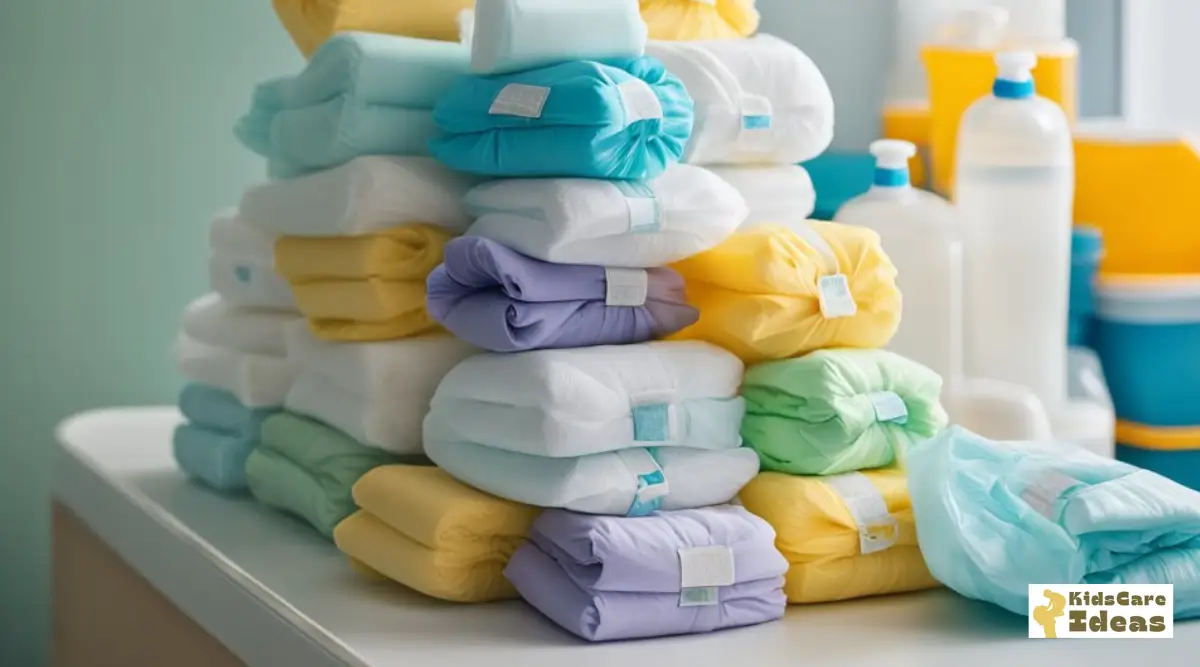Disposable diapers are made of three layers – inner, core, and outer. The inner layer is made of polypropylene plastic that comes into contact with the baby’s skin.
The core consists of fluff pulp derived from wood and superabsorbent polymers. The outer layer is made of polyethylene plastic, which is waterproof to prevent leaks.
In addition, some brands incorporate plant-based materials such as bamboo, cotton, or starch for the inner layer and core.

Let’s examine the components that go into making disposable diapers in detail.
Raw Materials That are Used To Make Disposable Diapers
| Raw Material | Description | Function |
|---|---|---|
| Super Absorbent Polymer (SAP) | Synthetic polymer that can absorb up to 30 times its weight in water | Absorbs and retains urine |
| Non-woven Fabrics | Soft, breathable fabric made by bonding together fibers without the need for weaving or knitting | Forms the topsheet and back sheet of the diaper |
| Polyethylene Film | Thin, waterproof plastic | Lines the back sheet of the diaper to prevent leaks |
| Elastic | Synthetic material that stretches and conforms to the baby’s body | Provides a snug fit and prevents leaks around the legs and waist |
| Adhesive | Hot melt adhesive that is applied to the diaper before it is assembled | Attaches the various components of the diaper. |
| Tapes | Combination of paper and synthetic fibers | Secures the diaper around the baby’s waist |
The Absorbent Pad: The Heart of Disposable Diapers
If you look into the core of disposable diapers, you will find an absorbent pad. This is the one that is responsible for absorbing and retaining your baby’s urine.
This crucial component is typically made of super absorbent polymers (SAPs). The SAPs are synthetic materials that possess an incredible ability to soak up liquid.
This is the most important material considered while making disposable diapers.
Do you know: that SAPs can absorb up to 30 times their weight in water, ensuring that your baby stays dry and comfortable throughout the day?
Non-woven Fabrics: A Soft Touch for Sensitive Skin
Soft, airy materials that feel kind against the baby’s sensitive skin surround the absorbent pad in non-woven fibers.
The smooth, non-irritating feel of these textiles is achieved by gluing together fibers without the need for weaving or knitting.
Both polypropylene and polyethylene, which are renowned for their softness and durability, are often used as non-woven materials in diapers.
Polyethylene Film: A Barrier Against Leaks
A thin layer of polyethylene film lines the diaper’s topsheet to keep it dry and prevent leaks.
Urine is kept inside the nappy and doesn’t leak into the baby’s clothing or bedding thanks to the barrier-like effect of this waterproof plastic.
Food packaging and other applications where preventing leaks is crucial frequently employ polyethylene, a sturdy and safe material.
Elastic: A Snug Fit for Comfort and Leak Prevention
An ideal fit around the baby’s waist and legs is mostly dependent on the elastic.
The elasticized fabric, usually composed of man-made fibers like spandex or rubber, aids in stopping leaks and maintaining the diaper’s position during vigorous play.
The efficiency of the diaper in absorbing and holding pee is improved in addition to the comfort it offers the infant.
Adhesive: Keeping It All Together
The strong and long-lasting adhesive that holds together a disposable diaper’s numerous parts is usually applied using a hot melt adhesive during the manufacturing process.
The diaper’s shape and integrity are maintained even when wet thanks to this glue, giving the infant dependable leak prevention.
Tapes: A Secure Closure for a Comfortable Fit
The last piece of equipment that fastens the diaper around the baby’s waist is tape, which is usually composed of a blend of synthetic and paper materials.
These sturdy, simple-to-fasten tapes offer a tailored fit, so the diaper remains snug and comfy all day.
Final Words
Let’s conclude the post!
Nowadays, you will see that these disposable diapers are a necessity for moms.
The combination of super absorbent polymers, non-woven fabrics, polyethylene film, elastic, adhesive, and tapes creates a product that is both effective and comfortable for babies, making parenting just a bit easier.
However, there may be diaper brands using some perfume, and chemicals in the manufacturing.
So, do check the components in the pack before you buy one for your baby.
